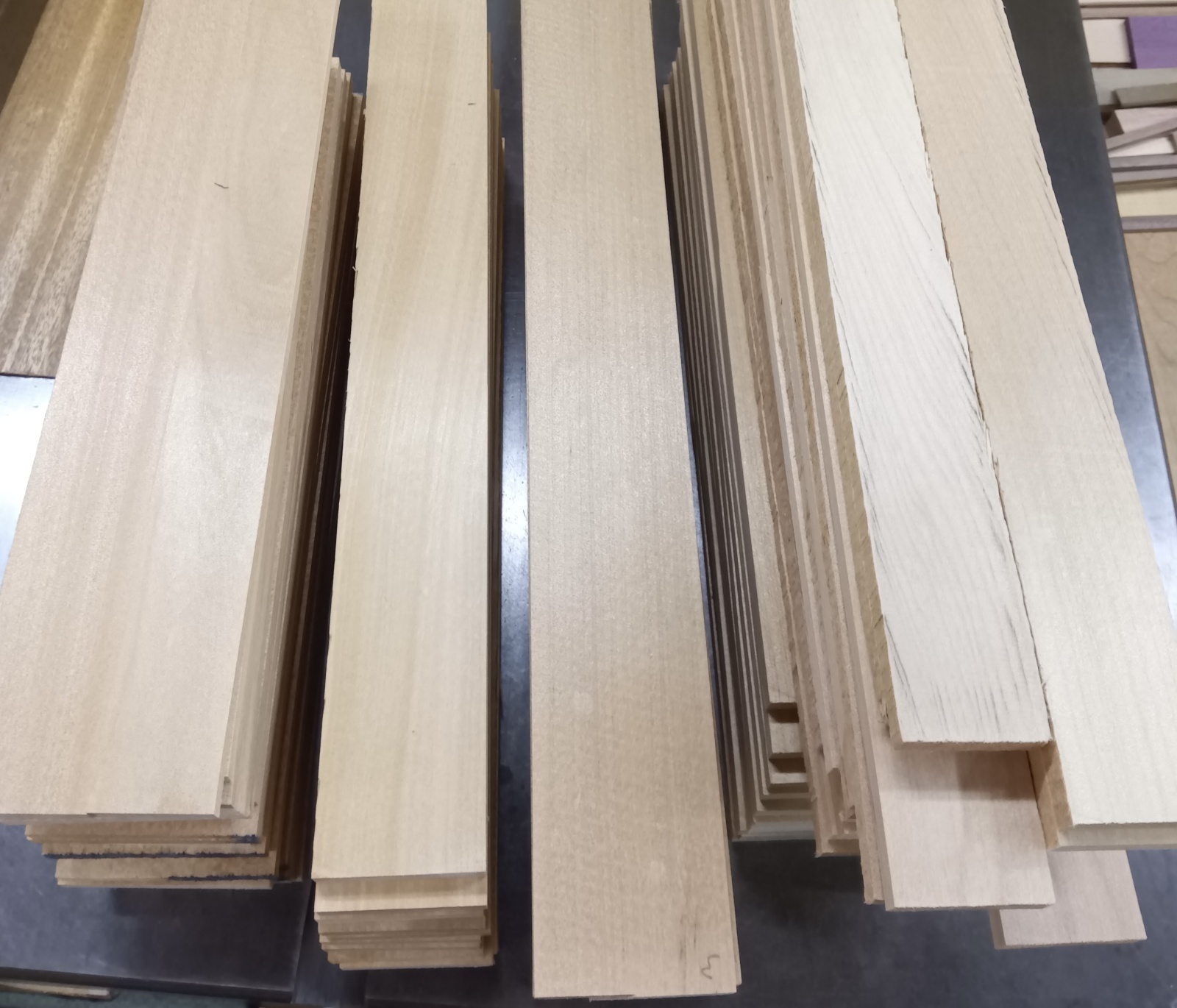Hexagonal box with a Light feeling

This morning the weather was nice again, but the forecast says it will get colder from this week, and I could already feel the temperature drop today. I worked a little on the panels for the hexagonal box, but most of my time went into preparing for the next job. I decided to start making the 5-sun 36-steps puzzle boxes that someone requested a long time ago. I could not start earlier because I could not get the yosegi sheets for them, so the order had been on hold. I finally managed to get a small amount, so I will make only as many boxes as I can with what I have. Because of that, I cannot keep any of these boxes as my stock.
My 36-steps boxes are based on my 27-steps puzzle boxes, but I add two more sliding keys, one more on each Kannuki (slide keys) panel. Because of that, I also need to make twice the number of internal parts, so the assembly takes much more work. Even so, I prepare the materials the same way as for the 27-steps boxes, and I did that process today. The thickness of the Aruki moving panels on the left, right, top, and bottom is the same as the 27-steps type, which is 8.5 mm. This time I am making about twenty boxes, so I cut the wood from large boards and shaved it down to the required thickness. The yosegi sheets have not been attached yet, so I will need to wait for that before I can continue.
The internal parts are also the same as those used for the 27-steps boxes, but since I need twice as many, I have to make some extra pieces. I expect to work on these while also continuing with the hexagonal box.
I am now making the panels for the hexagonal box and have just started attaching them. The color turned out brighter than I expected. I feel that a slightly heavier, darker color might have been better. Well, this is a matter of personal taste, but I think darker wood tones are generally more popular.
Since the main wood is Agathis, the box naturally ends up looking a bit bright anyway. But as I wrote before, I feel that the traditional image of a puzzle box is something light in both weight and feeling, so in that sense this result is actually nice. I once heard that puzzle boxes sold as Hakone souvenirs needed to be light so that people could carry them home easily. It was a long time ago, but the traditional puzzle boxes and other old trick boxes have that light and simple feeling, and that is one of the things I really like about them.
So I always feel that Katsura wood (from Japan) is necessary when I want to recreate that simple, natural feeling. Agathis is already quite light compared to many other woods, but it is still a bit heavier and more dense, and its texture is different from the unique softness that Katsura has.
My 36-steps boxes are based on my 27-steps puzzle boxes, but I add two more sliding keys, one more on each Kannuki (slide keys) panel. Because of that, I also need to make twice the number of internal parts, so the assembly takes much more work. Even so, I prepare the materials the same way as for the 27-steps boxes, and I did that process today. The thickness of the Aruki moving panels on the left, right, top, and bottom is the same as the 27-steps type, which is 8.5 mm. This time I am making about twenty boxes, so I cut the wood from large boards and shaved it down to the required thickness. The yosegi sheets have not been attached yet, so I will need to wait for that before I can continue.
The internal parts are also the same as those used for the 27-steps boxes, but since I need twice as many, I have to make some extra pieces. I expect to work on these while also continuing with the hexagonal box.
I am now making the panels for the hexagonal box and have just started attaching them. The color turned out brighter than I expected. I feel that a slightly heavier, darker color might have been better. Well, this is a matter of personal taste, but I think darker wood tones are generally more popular.
Since the main wood is Agathis, the box naturally ends up looking a bit bright anyway. But as I wrote before, I feel that the traditional image of a puzzle box is something light in both weight and feeling, so in that sense this result is actually nice. I once heard that puzzle boxes sold as Hakone souvenirs needed to be light so that people could carry them home easily. It was a long time ago, but the traditional puzzle boxes and other old trick boxes have that light and simple feeling, and that is one of the things I really like about them.
So I always feel that Katsura wood (from Japan) is necessary when I want to recreate that simple, natural feeling. Agathis is already quite light compared to many other woods, but it is still a bit heavier and more dense, and its texture is different from the unique softness that Katsura has.